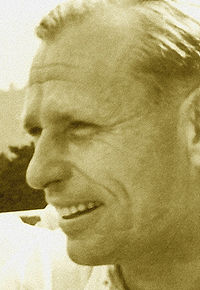Heinkel He 176 Video - First Jet Pilot - Flight Captain Erich Warsitz
|
|
Heinkel He 176
Heinkel He 176

Picture - World’s first aircraft to be propelled solely by a liquid-fuelled rocket
Role: Experimental
Manufacturer: Heinkel
Designed by: Walter Gx¼nter
First flight: June 20, 1939 - at the controls Test pilot Erich Warsitz
Status: Cancelled
Number built: 1
The Heinkel He 176 was a German rocket-powered aircraft. It was the world’s first aircraft to be propelled solely by a liquid-fuelled rocket, making its first powered flight on 20 June 1939 with Erich Warsitz at the controls.
Early experiments
During the 1920s, German daredevils had experimented with using solid-fuel rockets to propel cars, motorcycles, railway carriages, snow sleds, and, by 1929, aircraft such as Alexander Lippisch’s Ente and Fritz von Opel’s RAK.1. Solid-fuel rockets, however, have major disadvantages when used for aircraft propulsion, as their thrust cannot be regulated, and the engines cannot be shut down once fired.
In 1931, the Army Weapons Office testing ground at Kummersdorf had taken over research into liquid-fuel rockets. In 1932, Wernher von Braun designed a rocket of this kind which used high percentage spirit (alcohol) and liquid oxygen. With this he made the first experiments. In 1934 he fired his second rocket type, the A2, from the North Sea island of Borkum.

Picture - A regular He 112.
During 1936 von Braun's rocketry team working at Kummersdorf investigated installing liquid-fuelled rockets in aircraft. Ernst Heinkel enthusiastically supported their efforts, supplying a He 72 and later two He 112s for the experiments. Late in 1936 Erich Warsitz was seconded by the RLM to Wernher von Braun and Ernst Heinkel, because he had been recognized as one of the most experienced test-pilots of the time, and because he also had an extraordinary fund of technical knowledge. In June 1937, at Neuhardenberg (a large field about 70 kilometres east of Berlin, listed as a reserve airfield in the event of war), one of these latter aircraft was flown by test pilot Erich Warsitz with its piston engine shut down during flight, at which time it was propelled by von Braun’s rocket power alone. Despite the wheels-up landing and having the fuselage on fire, it proved to official circles that an aircraft could be flown satisfactorily with a back-thrust system through the rear.
At the same time, Hellmuth Walter's experiments into Hydrogen peroxide-based rockets were leading towards light and simple rockets that appeared well-suited for aircraft installation. Also the firm of Hellmuth Walter at Kiel had been commissioned by the RLM to build a rocket engine for the He 112, so there were two different new rocket motor designs at Neuhardenberg: whereas the von Braun’s engines were powered by alcohol and liquid oxygen, Walter engines had hydrogen peroxide and calcium permanganate as a catalyst. Von Braun’s engine used direct combustion and created fire, the Walter devices hot vapours from a chemical reaction, but both created thrust and provided high speed. The subsequent flights with the He 112 used the Walter-rocket instead of von Braun's; it was more reliable, simpler to operate and the dangers to test pilot Erich Warsitz and machine were less.
Heinkel He 176
Design and development
The allegation often repeated by technical experts that Heinkel made the first rocket aircraft, the He 176, as a ‘black machine’, without the approval of, or having been contracted by, the RLM, is totally false. In 1936, RLM awarded Heinkel a contract to build the world's first pure rocket aircraft, remaining fully informed of the project's progress and Heinkel’s intentions. During the development programme at Neuhardenberg with the He 112, the term "interceptor" had been coined, and the He 176 was seen as the research machine for the project. RLM was really thinking along the lines of a new kind of fighter aircraft. With a fantastic rate of climb it would take off almost vertically to intercept enemy bomber formations at 6000 - 7000 metres, make a swift attack from below at high speed, emptying the MGs or cannons into the enemy machines and then land once the fuel tanks were dry.
Because the He 176 development was classified top secret, Heinkel set up a special department in his Rostock-Marienehe works. A wooden barrack hut was erected first for the initial testing. Only very few employees were allowed access. This "shed" was soon converted into a permanent building. The development then progressed very quickly. Meanwhile work also went ahead to build the He 176 mock-up because time was pressing.
The He 176 was built as an all-metal aircraft to utilise one of the new Walter engines (HWK RI-203). Completely new was the wing-flow profile designed for supersonic speed whose leading edges were razor sharp. This increased the danger of losing the airstream at lower speeds needed for safe landings. The wings had been designed from the beginning as fuel containers but the riveting was problematical because the wings were so flat and only explosive studs were suitable, otherwise they would never have gotten leak-proof.
The He 176 did possess an advanced, totally-enclosed cockpit, with a frameless single-piece clear nose, through which the pilot's rudder pedal mounts were visible, and a flush upper cockpit glazing which was removable for entering the aircraft, making the cockpit fit completely within the forward, bullet-like contours of the fuselage. The landing gear was a combination of conventional and tricycle gear designs, with the main gear's struts intended to retract rearwards into the fuselage, with a fixed, aerodynamically faired nose wheel and strut, and a retractable tail wheel.
A unique feature of the He 176 was its jettisonable nose escape system. Compressed air was used to separate the nose from the aircraft. A drogue parachute was used to reduce the opening force required. After the drogue was deployed, the flush-fitting cockpit canopy was released and a conventional bailout occurred.
Maiden flight

Picture - Flight Captain Erich Warsitz.
With a new kind of aircraft like this one does not simply get in and take off. Ground work began with rolling tests to establish the characteristics on the runway at Peenemx¼nde.
Until then Heinkel had intentionally avoided demonstrating the machine to the Luftwaffe generals, but in the end a visit by an RLM party led by Udet, Milch and half the General Staff could no longer be put off.
Once Warsitz was convinced that he knew all the peculiarities and wrinkles of the aircraft through the programme of rolling trials and short leaps, one fine summer's evening (June 20, 1939) he announced spontaneously his decision to attempt the maiden flight immediately. A strange silence fell over all the engineers and assembly workers: nobody spoke, for all sensed that the decisive moment for the future was at hand.
Further flights and demonstrations
On the next day (June 21, 1939) Heinkel, Udet and a whole Staff of Peenemx¼nde officers came to witness the second successful flight. Erich Warsitz had his confidence up this second time and made an impressive pass at low level.
After this maiden flight, systematic development work was no longer possible. Despite all the secrecy the sensational news went round the higher circles at RLM like wildfire, and after that the He 176-Team basically did nothing but give demonstration flights - with immediate effect all future flights, including short leaps, were forbidden because a display had been arranged for the Fx¼hrer on July 3, 1939. The big air show for Hitler, the Party high-ups and the Luftwaffe Generals was to be at Rechlin.
Further development stopped
Heinkel was now a little bitter at not receiving the support he expected and needed, for after the first flights it seemed interest in it had died away. Not all people in the decisive area at RLM had lost interest, but war was looming and there were other things to think about. The Fx¼hrer-Directive, ordering all developments not ready for mass-production within a year to be suspended with immediate effect, led to the abandonment of Heinkel's rocket propulsion programme. Testing of the He 176 ended with only one aircraft being built. It was put on display at the Berlin Air Museum and was destroyed by an Allied bombing raid in 1943.
Prior to the cancellation of the programme, plans had been drawn up for a more sophisticated rocket-plane, still designated He 176. This was never constructed, but because it bore the same designation as the aircraft that was actually flown, many books and websites mistakenly publish pictures of it to illustrate its earlier namesake.
Germany did eventually fly an operational rocket-propelled fighter, the Me 163 Komet, but this was made by the competing Messerschmitt firm, using an engine that was a further development of the one that powered the He 176.
Specifications (He 176 V1)
General characteristics
Crew: One
Length: 5.2 m (17 ft 1 in)
Wingspan: 5.0 m (16 ft 5 in)
Height: 1.5 m (4 ft 11 in)
Wing area: 5.4 m² (58 ft²)
Empty weight: 900 kg (1,980 lb)
Loaded weight: 1,620 kg (3,570 lb)
Performance
Maximum speed: 345 km/h [750 km/h theoretical] (215 mph [470 mph theoretical])
Range: 95 km [theoretical] (60 mi)
Service ceiling: 9,000 m [theoretical] (29,500 ft)
Rate of climb: 60.6 m/s (199 ft/s)
Endurance 50 s
Comparable aircraft
GIRD RP-218
Related lists
List of military aircraft of Germany
Cultural references
Rocketmen, documentary produced by film director Philip Osborn in 2009.
Sources
Warsitz: The First Jet Pilot - The Story of German Test Pilot Erich Warsitz, Lutz (2009). Pen and Sword Books. 978-1-84415-818-8. English Edition
Heinkel He 176 Pictures and Heinkel He 176 for Sale.
Living Warbirds: The best warbirds DVD series.
Source: WikiPedia